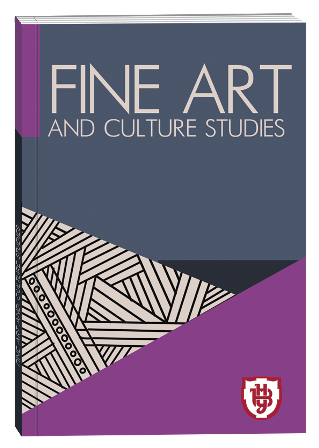A CYCLE OF PASCHAL HYMNS FROM THE LITURGY OF JOHN CHRYSOSTOM FROM A MID – SEVENTEENTH-CENTURY MANUSCRIPT OF PRZEMYSL IN THE CONTEXT OF ANCIENT DOCTRINES OF ETHOS AND CATHARSIS
DOI:
https://doi.org/10.32782/facs-2023-2-7Keywords:
philosophy of music, Paschal hymn, catharsis, ethos, chiasmus, modes.Abstract
The article presents a philosophical and musical study of ethos and catharsis in the cycle of Easter hymns of the monophonic Liturgy of John Chrysostom from the Przemysl manuscript of the mid-seventeenth century, namely: "Christ is the new Easter", "Shine, shine new Jerusalem", "Myrrh-bearing women", "O divine", "Angel cries out", "O Easter is great", analysing the musical elements of each hymn. The musical forms of each individual work included in the cycle of Easter hymns are described, through which ethos and catharsis are revealed. It is found that in each Easter piece all kinds of ethical modes according to Plato and Aristotle are used, which led to cathartic manifestation. In the hymn "Christ is the New Pascha", the Doric mode encourages cathartic reconciliation: "take away the sins of the whole world". In the hymn "Shine, Shine New Jerusalem", the alternation of Phrygian and Dorian modes enhances the cathartic climax "you are pure". The ending of the phrases in the Doric and Phrygian modes in the hymn "Myrrh-bearing women" gives rise to the cathartic manifestation of "resurrection". The cathartic relief of suffering is most clearly manifested in the cathartic relief of "rising three days from the grave", accompanied by the Phrygian and Lydian modes in the Easter piece "Angel cries out". The author reveals the culminating tension that leads to amphoteric sound, which in turn creates chiasmus, the intersection of joyful and sad emotions, which is most clearly demonstrated in the work "Angel cries out". The peculiarities of the dotted rhythm in the hymn "Myrrh-bearing women" and the Lombard rhythm in the hymn "Shine, shine new Jerusalem" are determined. The Phrygian, Dorian, and Lydian modes are distinguished, which harmoniously combine with each other and lead to a cathartic emotion. Based on the study of the musical text in the cycle of Easter hymns, it is concluded that the method of analysing musical forms through ethos and catharsis is a promising approach for the philosophical and musical understanding of sacred works.
References
Балуцька Н.М. Літургія Йоана Златоустого з Перемишльського ірмолоя. / Молоде музикознавство. Наукові збірки Львівської національної музичної академії ім. М. В. Лисенка. Вип. 20. Львів : Сполом, 2008. С. 128–134.
Драганчук, В.М. Музична психологія і терапія: навч. посіб. для студ. спец. «Музичне мистецтво» / В. Драганчук; передм. Л. Кияновської. Східноєвр. нац. ун-т ім. Лесі Українки, 2016. 230 с.
Карпенко А.П. Музичний катарсис як частина здоров’язберігаючих технологій навчання. Гуманітарний вісник. Педагогіка. 2012. №27 С. 116–120.
Літургія Йоана Златоустого з Перемишльського рукопису середини XVII століття /упор. Н. Балуцька, Н. Сиротинська; ред. Кр. Ганнік і Ю. Ясіновський /Інститут Літургійних Наук Українського Католицького Університету, Lehrstuhl für Slavische Philologie der Bayerischen Julius-Maximilian Universität zu Würzburg [=Антологія візантійськослов’янської церковної монодії, 7]. Львів: в-во УКУ, 2008. 23 с.
Мельничук М.М. Сугестивно-катарсичні особливості музично-духовного мистецтва в контексті української релігійності. Вісник Житомирського державного університету ім. І. Франка. Релігієзнавство, 2021. №2(90). С. 20–29.
Мішин В.Ю. Вчення про музичний етос у класичну епоху. Молодий вчений, 2018. №2. С. 537–542.
Падалка В.В. Катарсис етичний та естетичний. Магістеріум. Історико-філософські студії. Національний університет «Києво-Могилянська академія», Київ. 2000. Вип. 3. С. 21–27.
Соловйов В.А. Катарсис як ефект впливу музичного твору. Web of Scholar, 2018. 2(20) Vol. 5 С. 98–102. https://ws-conference.com/webofscholar
Xiao C. Катартичні аспекти інтерпретативного синтезу як основи оперного образу. Музичне мистецтво і культура, 2022. 2(33). С. 175–187. https://doi.org/https://doi.org/10.31723/2524-0447-2021-33-2-15
Яременко К.С. Музична психотерапія / К.С. Яременко // Актуальні напрями практичної психології і психотерапії : матеріали VIII Міжнар. наук.- практ. конф. молодих вчених, студентів та аспірантів (м. Харків, 16 груд. 2020 р.). Харків: ХНУВС, 2020. С. 224–227.
Ford A. 2004. Catharsis: The Power of Music in Aristotle’s Politics. Music and the Muses: The Culture of Mousike in the Classical Athenian City. 2004. P. 309–336 https://doi.org/10.1093/acprof:oso/9780199242399.003.0012
Janko R. From Catharsis to the Aristotelian Mean. /R. Janko // Essays on Aristotle’s Poetics; ed. A. Rorty. Princeton: «Princeton university press», 1992. P. 341–349.
Lear J. Katharsis. /J.Lear // Essays on Aristotle’s Poetics; ed. A. Rorty. Princeton: «Princeton university press», 1992. Р. 315–340.
Young J.O. Assessing the Ethos Theory of Music. Disputatio, 2021. Vol. 13, № 62. P. 283–297. doi: 10.2478/disp- 2021-0015







